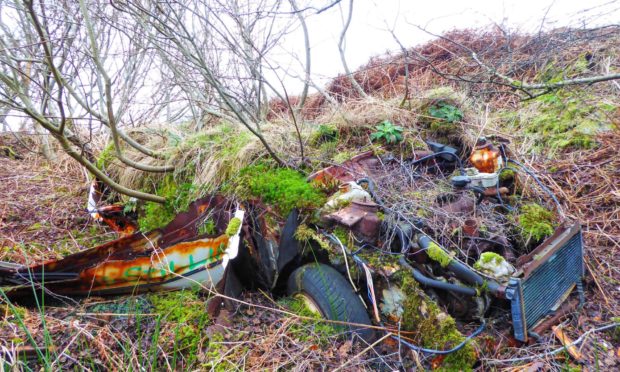I’d spotted it from at least two kilometres away – the tell-tale reflection of sun off metal. It looked like a vehicle but, being miles from anywhere on a rough tussocky hillside, that seemed unlikely. Still, I had to find out.
One substantial diversion and two access-unfriendly deer fences later, I found myself standing next to a red Suzuki jeep. The rear door had come off, the exhaust was lying nearby and some of the windows were missing their glass. But other than that, it was in pretty good nick. It had clearly been there for years though, and while I’m certainly not a car person, even I could see it was from a strange distant time when vehicle manufacturers liked straight edges.
If I’d been walking through town and it was decaying in someone’s driveway I wouldn’t have given this vehicle a second glance, but out here it was wonderfully incongruous.
The wheels were half hidden in the ground but the surrounding land had been eroded away, presumably by sheep. The result was a vehicle sitting on a grassy plinth, held aloft at a jaunty angle and presented like a piece of art in a gallery: “A commentary on the impermanence of humanity and our transitory intrusion into wild places.”
Hmm, or perhaps it’s just a vehicle that got stuck? Either way, I was glad I encountered it. Of course, I’d rather it wasn’t there but, seeing as it was, I had to admit I quite liked it.
Over the years, I’ve happened upon an assortment of vehicles in various states of decay – in disused railway tunnels, at the bottom of embankments, or marooned in dense forests with no way in or out.
Standouts include a Vauxhall Viva on its side in a Moray woodland, a 1940s Morris in an Aberdeenshire forest, and “something” in Cowal – unidentifiable on account of it now being a mossy tree-covered hump with a radiator at one end.
In dense forest settings you wonder how cars could possibly have been driven in there, but then you deduce that they must have arrived before the trees, which really fires the imagination when the trees themselves are old.
Slowly, while nobody is looking, litter becomes interesting
We love mysteries, so there’s naturally something alluring about vehicle wrecks. But ultimately, they’re just litter. Machinery dumped in the countryside and left to rot. I see loads of litter in my ranger job and I genuinely hate it.
Just this month we had a burned-out car in the park where I work. It looked truly awful. Nobody in their right mind would have wanted it to stay there and so it was quickly removed. So what makes knackered old vehicles in weird places acceptable? We don’t tolerate litter in the countryside so why do we tolerate these?
Someone told me the Viva was one of many vehicles “disposed of” by a local businessman who charged folk to get rid of their old vehicles for them. The customers didn’t ask, and the businessman didn’t tell. But I’m certain that if you found a modern dumping site, full of contemporary cars with broken glass and batteries scattered about, you’d be appalled and you’d report it. But if you found a forest full of Hillman Imps, Austin Allegros and Morris Minors… well, you’d be shocked but doubtless you’d be smiling rather than scowling. You’d be Instagramming it and unwittingly turning it into a tourist destination.
It’s funny isn’t it, how the passage of time somehow moves items from being litter to something else entirely, because so much of what gets dug up by archaeologists is exactly that – the stuff we discard. It tickles me to think of ranger services asking people not to poo irresponsibly, but at the same time we’ve got archaeologists pushing their noses and wee brushes through ancient middens.
Slowly, while nobody is looking, litter becomes interesting. It becomes history. And if nature is slowly reclaiming it, so much the better. As a ranger, I advocate the worthy ethos of ‘Leave no Trace’, but if we truly did all live up to that lofty ideal, would archaeologists have anything left to dig up?
As for my Suzuki, I later found photos online from 2009, showing it in exactly the same location, in pretty much the same condition. So yep, it was clearly quite old. But was it still litter? At what point does litter become fascinating archaeology? I don’t have an answer I’m afraid. I’m just glad I had shelter for eating my sandwiches.
Ben Dolphin is an outdoors enthusiast, countryside ranger and former president of Ramblers Scotland

